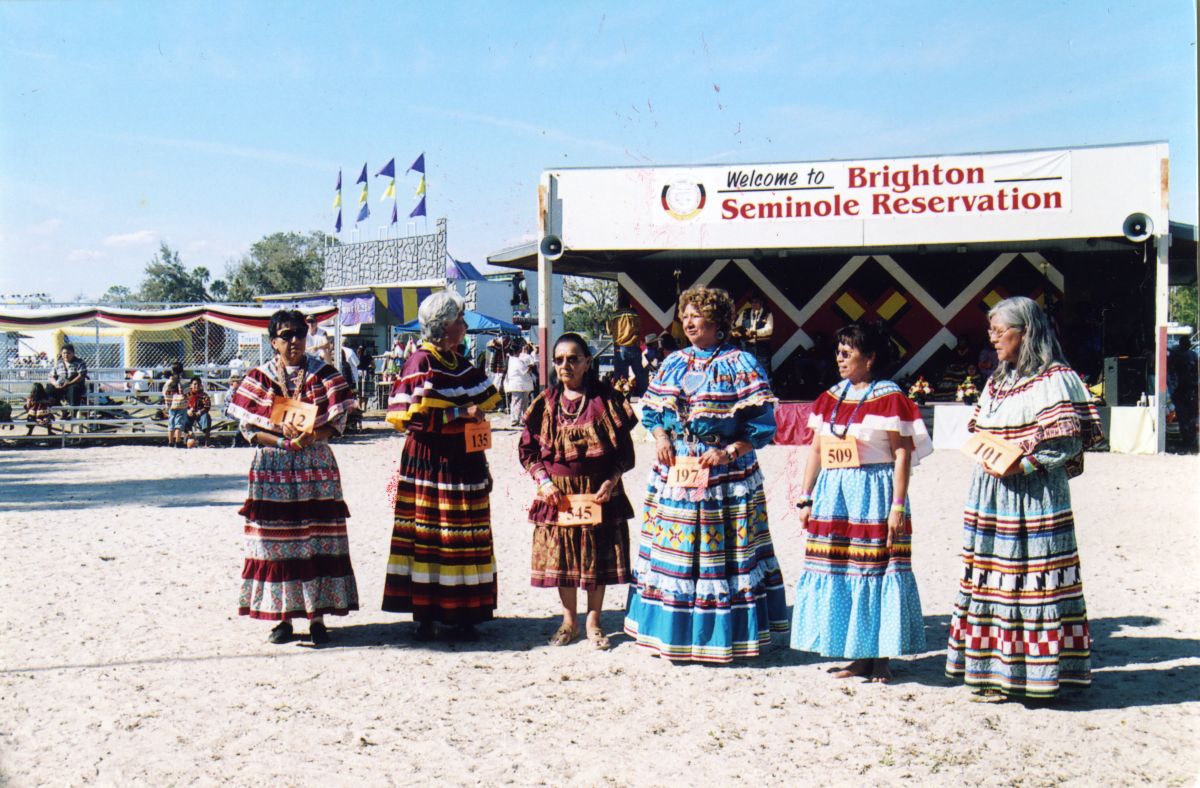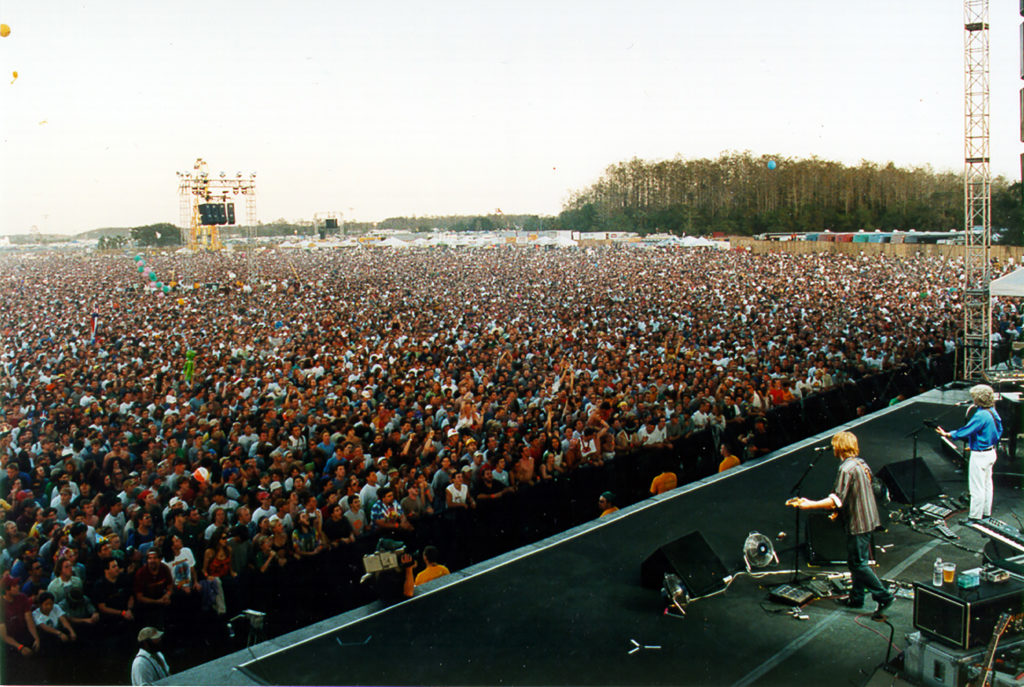
Seminole Fashion: A Vibrant Reflection of Culture and Resilience
Seminole fashion has long been synonymous with Seminole tourism. Colorful patchwork, intricate dolls, and beadwork are all hallmarks of Seminole fashion that can be seen throughout the many decades of Seminole tourism history. This week, join us to explore Seminole fashion, how it has shifted over time, how it has become an important part of Seminole tourist ventures, and it became a reflection of Seminole resilience and culture. We will explore hairstyles, patchwork, and beadwork as we trace the cultural importance of Seminole fashion on the tourism industry.
In this week’s featured image, you can see fashion show contestants showing off their entries at a rodeo on the Brighton Seminole Indian Reservation in 1983. The State Archives of Florida hosts the image through the Florida Memory Project. Seminole fashion shows and clothing contests have a long history, and are popular at Seminole events. Interested in seeing a Seminole clothing contest yourself? We encourage you to attend next year’s Seminole Tribal Fair and Pow Wow.
Beaded Necklaces
Beaded necklaces were, and remain to be, a very typical Seminole women’s fashion accessory. It is easy to see how a woman could accumulate dozens of necklaces over her lifetime. By the trading post era, necklaces were made of glass beads, and were an important part of a Seminole woman’s daily routine. These necklaces may also be adorned by flattened metal, such as coins, or even shells. In Patsy West’s Reflections #145, she speaks on the daily routine of a Seminole woman putting on, wearing, and removing her beads. Women would store the beads in a basket from the night before. When she woke, she would place them on her neck with bunches tied with string. Removing them would reverse the process, clipping the strings and placing them in the basket. Some women could wear as much as 15 pounds of beads!
Below, Lottie Shore picks out seed beads to use on a men’s beaded sash in White Springs, FL in 1984. She wears a long skirt with intricate patchwork and rickrack and a sheer purple cape. Around her neck, you can see dozens of beaded necklaces. While beaded necklaces are still popular today, the volume of dozens of necklaces worn at a time is no longer the standard.

(State Archives of Florida/Nusz)
Beaded Sashes and Bags
Beaded sashes and bags were typical menswear for much of the 18th and 19th centuries. Although almost nonexistent in the 20th century, there is still a significant photographic and museum record of beaded Seminole bags and sashes. One famous sash in the Ah-Tah-Thi-Ki Museum Collection is the recently acquired sash of Chief Osceola. The beaded, finger-woven woolen sash features a chevron pattern and delicate seed beads. Patterns like those seen on Osceola’s sash may have been specific to the individual, and only used by one person or maker. Beaded bandolier bags were popular during the 1800s, with the last of them made by 1870. At the 2019 Florida Folk Festival, modern Seminole bandolier bag maker Brian Zepeda spoke on reviving the art of making bandolier bags in the last 20 years. Zepeda noted that sometimes it can take up to two years to complete a bandolier bag.

GRP1896.228, ATTK Museum
Above, you can see a Seminole man dressed in late 19th or early 20th century clothing. This typically included a turban, longshirt, leggings, and sashes. This photograph is a copy of a historic photograph by Frederick Andrew Metcalfe. In it, Tallahassee (Deer Clan) poses wearing Seminole men’s fashion of the 19th century. You may notice that while he wears a bigshirt, it does not yet feature patchwork. This would only become popular later in the 20th century with the adoption of sewing machines. The description notes that he wears two different sashes, “of two distinct types: one is embroidered beadwork on wool, while the other is heddle-loomed woolen yarn with large beads added during the weaving process. The latter technique was used for the garters, while the leggings exhibit beadwork embroidery on wool.”
Patchwork
Patchwork is one of the most iconic and recognizable Seminole fashions. By the 1900s, the end of trading posts and the draining of the Everglades through a series of canal projects would put serious economic strain on Seminoles. Up until this point, they lived in relative isolation, trading with trusted outsiders. Around this time, sewing machines also became typical household items. This, coupled with the rise of Seminole tourist camps, allowed patchwork to develop around the 1910s. Born out of necessity, patchwork would become synonymous with Seminole culture and tourism. Initially, patchwork was relatively simple and usually featured only two colors. Makers would create patterns by cutting, rotating, flipping, and mirroring long strips and bands of fabric. Over time, patchwork would become more intricate, with individual makers creating their own styles.
Seminole clothing would also shift over time due to other outside influences. For example, during WWII calico and applique ribbons would become scare, as the ink was a German export. In response, patchwork became increasingly popular, and Seminole fashion trended away from calico fabrics and applique. Today, patchwork is very intricate and bold with finished pieces adored by rickrack. Many patchwork patterns are inspired by Seminole legends. Others have personal meaning, or were only intended for one wearer or family. Clothing contests, like the one in our featured image this week, have been popular at Seminole events for decades. Not only are they important for artists to show off their work, they are also a way to “preserve older styles of clothing.” For items that are no longer in fashion, like men’s medicine coats, clothing contests are a way to keep these artistic styles alive.
Men’s and Women’s Styles
Both men’s and women’s clothing styles have significantly shifted throughout the last 100 years. One such interesting moment occurred with the introduction of patchwork poodle skirts supported with crinoline during the 1950s and 60s. This intersection of broader American culture melding with Seminole culture would continue to affect Seminole styles throughout the years. But, patchwork itself remained the backbone of traditional and typical Seminole clothing. Even as skirts became shorter with the trends, patchwork persisted as a vital part of Seminole culture and identity.
Often, women’s styles feature a simple, tucked in shirt under a long skirt and covered by a cape. In more recent times, these capes are made of sheer or gauzy fabrics. While the items can stand alone, they are often made to complement each other in some way. Many times, the women’s skirts are the most popularly worn item, and the most intricate. Men’s styles have also see some significant trend shifts over the years, most notably the shift from “Medicine Man Coats” to jackets and vests. This shift mirrored the American fashion trends of the time, and included a shift away from the longer bigshirts of the past. Shorter jackets, vests, and shirts became more typical menswear. Whatever the style, they all feature the intricate patchwork.
Hairstyles
Prior to the 1900s, women typically would wear tight buns, with long bangs. Traditional men’s haircuts prior to the 1900s included: “shaved the sides of their heads, left a fringe around the face, and left a scalp lock down the crown of their head, which terminated in two braided ques” and covered by turbans. Hair was closely tied to identity and indicated significant life changes. In Patsy West’s Reflections #136, she notes that: “Until the 1950s, a Seminole woman’s hair was only publicly let down in times of personal mourning, a custom practiced by a woman and her kinswomen.” As more interaction began with American culture, hairstyles began to shift. Men began to sport more typical American styles, like bowl cuts. Women’s buns became softer, larger, and less severe.
Eventually, women’s styles shifted in the 1930s to include elaborate, large cardboard accessories to add shape. This included: “A fitted crown of cloth-covered cardboard or other flat material replaced the cloth roll, giving their hair a definitely pronounced shape. Then, in the 1940s, hair fashion reigned supreme with women appearing to `out do’ one another with extravagant hair board shapes.” In the subsequent decades, more American styles have also become typical, like modern ponytails, hair worn loose, and other styles.
While some elders choose to wear their hair in older styles, now Seminoles wear their hair in a variety of ways to express individual tastes. Below, you can see Frances Willie smiling after completing her hairstyle on April 19, 1948. Her hair features one of these large cardboard shapers. Willie wore her hair in this fashion for 25 years. Willie is also wearing a variety of beaded necklaces, over a sheer cape fringed with rickrack.
Seminole Dolls as a Reflection of Seminole Fashion
Often, Seminoles fashion is reflected in tiny recreations seen on Seminole dolls. Typically, Seminole dolls are not made to have realistic features that resemble any person. Realistic dolls “would bring harm to the person it looked like, as well as to the person who made it.” Thus, Seminole dolls feature stylized features and typical Seminole fashions like patchwork and hairstyles to reflect Seminole culture. These dolls became important to the tourist trade, with Seminoles selling them at tourist camps beginning in the early 20th century. Seminole dolls also represent Seminole resilience, ingenuity, and a willingness to adapt in the face of struggle. Prior to the 1910s, Seminole dolls were made of cloth and predominantly faceless and featureless. This soon changed, with the introduction of wood and palmetto dolls. Palmetto dolls became especially popular.
With the rise of tourist camps, Seminoles found there was outside interest in their crafts. Soon, Seminole dolls began to feature typical Seminole fashions like patchwork and hairstyles. Female dolls typically are dressed in patchwork skirts, sometimes with capes, and adorned with elaborate hair, beaded necklaces, and earrings. Male dolls are dressed in bigshirts and turbans. By the 1940s, Seminole dolls became an important part of the Seminole tourist economy. They are still popular and sold today. Below, you can see a matched pair of palmetto fiber dolls. Notice the stitched features, hairstyle and turban, patchwork, rickrack, and beaded jewelry.

GRP1900.75, ATTK Museum Collection
Appropriation
It is important to note that like many indigenous cultures and fashions, appropriation remains a difficult barrier. All too often, art and fashion that are important to Seminole culture and identity, such as patchwork designs, are stolen for profit. To learn more, we encourage you to read our previous blog post on Cultural Appropriation vs. Appreciation in our Ethics series.
Much like Seminole culture, Seminole fashion has shifted, melded, and changed throughout time. Much more than just clothing or hairstyles, Seminole fashion continues to mirror significant transition points in Seminole culture and history. Closely tied with Seminole tourism, it has also persisted as a vital reflection of Seminole identity, resilience, and adaptation to a changing world.
Author Bio
Originally from Washington state, Deanna Butler received her BA in Archaeological Sciences from the University of Washington in 2014. Deanna moved to South Florida in 2016. Soon, she began working for the Seminole Tribe of Florida’s Tribal Historic Preservation Office. Deanna was the THPO’s Archaeological Collections Assistant from 2017-2021. While at the THPO, Deanna worked to preserve, support, and process the Tribe’s archaeological collection. She often wrote the popular Artifact of the Month series, and worked on many community and educational outreach programs. She lives in Fort Myers, FL with her husband, son, and dog.




